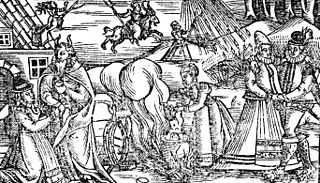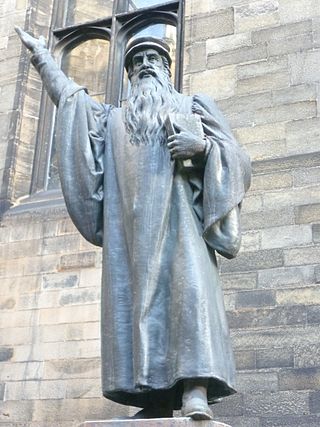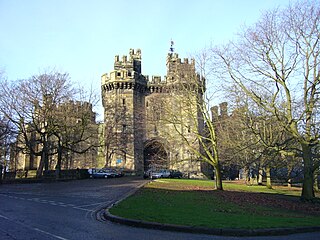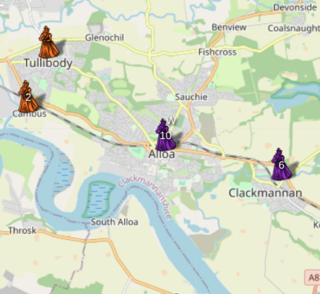Related Research Articles

Isobel Gowdie was a Scottish woman who confessed to witchcraft at Auldearn near Nairn during 1662. Scant information is available about her age or life and, although she was probably executed in line with the usual practice, it is uncertain whether this was the case or if she was allowed to return to the obscurity of her former life as a cottar’s wife. Her detailed testimony, apparently achieved without the use of violent torture, provides one of the most comprehensive insights into European witchcraft folklore at the end of the era of witch-hunts.

The North Berwick witch trials were the trials in 1590 of a number of people from East Lothian, Scotland, accused of witchcraft in the St Andrew's Auld Kirk in North Berwick on Halloween night. They ran for two years, and implicated over 70 people. These included Francis Stewart, 5th Earl of Bothwell, on charges of high treason.
The Aix-en-Provence possessions were a series of alleged cases of demonic possession occurring among the Ursuline nuns of Aix-en-Provence in 1611. Father Louis Gaufridi was accused and convicted of causing the possession by a pact with the devil, and he was tortured by strappado and his bones dislocated. He was then executed on April 1611 by strangulation and his body burned. This case provided the legal precedent for the conviction and execution of Urbain Grandier at Loudun more than 20 years later. This event led to possessions spreading to other convents and a witch burning in 1611.

The Scottish Reformation was the process whereby Scotland broke away from the Catholic Church, and established the Protestant Church of Scotland. It forms part of the wider European 16th-century Protestant Reformation.

Agnes Sampson was a Scottish healer and purported witch. Also known as the "Wise Wife of Keith", Sampson was involved in the North Berwick witch trials in the later part of the sixteenth century.

Major Thomas Weir was a Scottish soldier and presumed occultist, executed for bestiality, incest and adultery.

The trials of the Pendle witches in 1612 are among the most famous witch trials in English history, and some of the best recorded of the 17th century. The twelve accused lived in the area surrounding Pendle Hill in Lancashire, and were charged with the murders of ten people by the use of witchcraft. All but two were tried at Lancaster Assizes on 18–19 August 1612, along with the Samlesbury witches and others, in a series of trials that have become known as the Lancashire witch trials. One was tried at York Assizes on 27 July 1612, and another died in prison. Of the eleven who went to trial – nine women and two men – ten were found guilty and executed by hanging; one was found not guilty.

The Samlesbury witches were three women from the Lancashire village of Samlesbury – Jane Southworth, Jennet Bierley, and Ellen Bierley – accused by a 14-year-old girl, Grace Sowerbutts, of practising witchcraft. Their trial at Lancaster Assizes in England on 19 August 1612 was one in a series of witch trials held there over two days, among the most infamous in English history. The trials were unusual for England at that time in two respects: Thomas Potts, the clerk to the court, published the proceedings in his The Wonderfull Discoverie of Witches in the Countie of Lancaster; and the number of the accused found guilty and hanged was unusually high, ten at Lancaster and another at York. All three of the Samlesbury women were acquitted.

Queen of Elphame or "Elf-hame", in the folklore belief of Lowland Scotland and Northern England, designates the elfin queen of Faerie, mentioned in Scottish witch trials. In ballads and contemporary texts, she is referred to as Queen of Elphane, Elphen, or the Fairies. She is equivalent to the Queen of Fairy who rules Faërie or Fairyland. The character as described in witch trials has many parallels with the legends of Thomas the Rhymer and Tam Lin.

In early modern Scotland, in between the early 16th century and the mid-18th century, judicial proceedings concerned with the crimes of witchcraft took place as part of a series of witch trials in Early Modern Europe. In the Late Middle Ages, there were a handful of prosecutions for harm done through witchcraft, but the passing of the Witchcraft Act 1563 made witchcraft, or consulting with witches, capital crimes. The first major issue of trials under the new act were the North Berwick witch trials, beginning in 1590, in which King James VI played a major part as "victim" and investigator. He became interested in witchcraft and published a defence of witch-hunting in the Daemonologie in 1597, but he appears to have become increasingly sceptical and eventually took steps to limit prosecutions.

The great Scottish witch hunt of 1649–50 was a series of witch trials in Scotland. It is one of five major hunts identified in early modern Scotland and it probably saw the most executions in a single year.
Geillis Duncan also spelled Gillis Duncan was a young maidservant in 16th century Scotland who was accused of being a witch. She was also the first recorded British named player of the mouth harp.

The 1594 trial of alleged witch Allison Balfour or Margaret Balfour is one of the most frequently cited Scottish witchcraft cases. Balfour lived in the Orkney Islands of Scotland in the area of Stenness. At that time in Scotland, the Scottish Witchcraft Act 1563 had made a conviction for witchcraft punishable by death.

Witchcraft in Orkney possibly has its roots in the settlement of Norsemen on the archipelago from the eighth century onwards. Until the early modern period magical powers were accepted as part of the general lifestyle, but witch-hunts began on the mainland of Scotland in about 1550, and the Scottish Witchcraft Act of 1563 made witchcraft or consultation with witches a crime punishable by death. One of the first Orcadians tried and executed for witchcraft was Allison Balfour, in 1594. Balfour, her elderly husband and two young children, were subjected to severe torture for two days to elicit a confession from her.

Margaret Aitken, known as the Great Witch of Balwearie, was an important figure in the great Scottish witchcraft panic of 1597 as her actions effectively led to an end of that series of witch trials. After being accused of witchcraft Aitken confessed but then identified hundreds of women as other witches to save her own life. She was exposed as a fraud a few months later and was burnt at the stake.

The Bute witches were six Scottish women accused of witchcraft and interrogated in the parish of Rothesay on Bute during the Great Scottish Witch Hunt of 1661–62. The Privy Council granted a Commission of Justiciary for a local trial to be held and four of the women – believed by historians to be Margaret McLevin, Margaret McWilliam, Janet Morrison and Isobell McNicoll – were executed in 1662; a fifth may have died while incarcerated. One woman, Jonet NcNicoll, escaped from prison before she could be executed but when she returned to the island in 1673 the sentence was implemented.
Beatrix Leslie was a Scottish midwife executed for witchcraft. In 1661 she was accused of causing the collapse of a coal pit through witchcraft. Little is known about her life before that, although there are reported disputes with neighbours that allude to a quarrelsome attitude.
Alison Pearson was executed for witchcraft. On being tried in 1588, she confessed to visions of a fairy court.
The Witches of Bo'ness were a group of women accused of witchcraft in Bo'ness, Scotland in the late 17th century and ultimately executed for this crime. Among the more famous cases noted by historians, in 1679, Margaret Pringle, Bessie Vickar, Annaple Thomsone, and two women both called Margaret Hamilton were all accused of being witches, alongside "warlock" William Craw. The case of these six was "one of the last multiple trials to take place for witchcraft" in Scotland.

Margaret Duchill was a Scottish woman who confessed to witchcraft at Alloa during the year 1658. She was implicated by others and she named other women. She was executed on 1 June 1658.
References
- ↑ Uglow, Jennifer (1999). The Northeastern Dictionary Of Women's Biography: Revised by Maggy Hendry (3rd ed.). Boston: Northeastern University Press. ISBN 155553421X.
- ↑ Black, George F. (2003). A calendar of cases of witchcraft in Scotland, 1510–1727. Whitefish, MT: Kessinger Publishing. ISBN 0766158381.
- ↑ Levack, Brian P. (1992). Witchcraft in Scotland (Reprint of works orig. publ. 1891–1984. ed.). New York [u.a.]: Garland. ISBN 0815310293.
- ↑ Chambers, R (1824). Traditions of Edinburgh. Edinburgh: W & R Chambers Ltd. reprint 1980. p. 33. ISBN 0-550-21292-2.
- 1 2 "Supernatural Scotland: Major Weir". Scottish Clans. Archived from the original on 28 October 2012. Retrieved 12 August 2013.